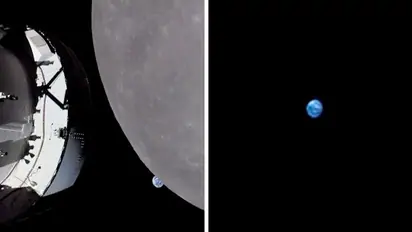NASA's Orion spacecraft clicks stunning images of Moon, Earth; Check out

Synopsis
NASA's Artemis spacecraft has successfully arrived at the moon after finally blasting off from Earth last week. The spacecraft also sent back images of Earth looking extremely tiny like a 'pale blue dot' from 230,000 miles( 370149.12 km) away. Check them out.
NASA's Orion space capsule reached the Moon on Monday (November 21). Although it didn't land on the Moon's surface, it was just 81 miles away when flying close to Earth's only satellite. The far side of the Moon, which is usually black, was whirled around by Orion. Since NASA's Apollo programme 50 years ago, this is the first time a spacecraft has visited the Moon. A significant accomplishment for NASA is the Orion spacecraft.
When the crew capsule and its three wired-up dummies were on the other side of the moon, the near approach of 81 miles (130 km) happened as the capsule's cameras snapped a photo of Earth. NASA said so far the mission has "exceeded expectations" since last week's launch.
Also Read | Vikram-S, India's first privately-developed rocket, successfully launched
The aircraft also sent back images of Earth looking extremely tiny like a 'pale blue dot' from 230,000 miles( 370149.12 km) away.
A little over an hour later, Orion flew over Tranquility Base, the site of the July 20, 1969, landing of Neil Armstrong and Buzz Aldrin.
Also Read | NASA's Orion spacecraft shows first images of Earth on its way to Moon
Earlier on Saturday, NASA also published a collection of breath-taking Orion selfies, showcasing the human-rated spacecraft shimmering against the blackness of space. The Orion spacecraft was intended to circle the moon for about a week. On December 11, it will make a splashdown in the Pacific Ocean.
Also Read | NASA's next-generation Artemis-1 mission finally lifts off 50 years after Apollo